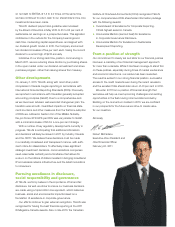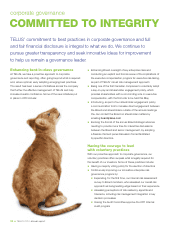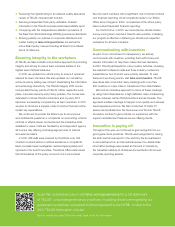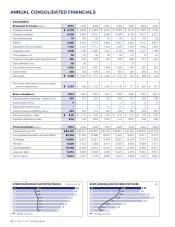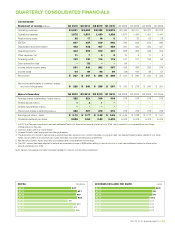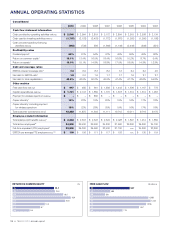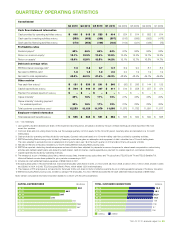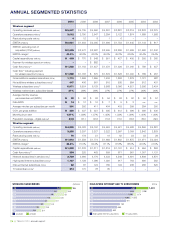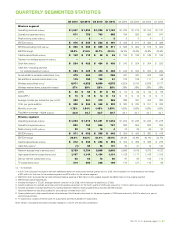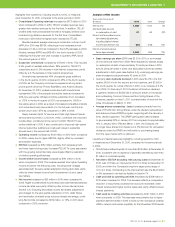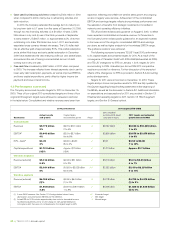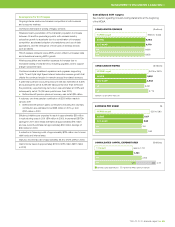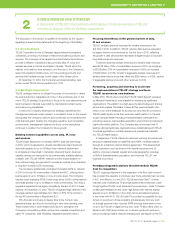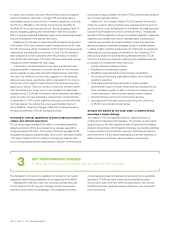Telus 2010 Annual Report Download - page 42
Download and view the complete annual report
Please find page 42 of the 2010 Telus annual report below. You can navigate through the pages in the report by either clicking on the pages listed below, or by using the keyword search tool below to find specific information within the annual report.38 . TELUS 2010 annual report
This document contains forward-looking statements about expected
future events and financial and operating performance of TELUS
Corporation (TELUS or the Company, and where the context of the
narrative permits, or requires, its subsidiaries). By their nature, forward-
looking statements require the Company to make assumptions, and
forward-looking statements are subject to inherent risks and uncertainties.
There is significant risk that assumptions, predictions and other forward-
looking statements will not prove to be accurate. Readers are cautioned
not to place undue reliance on forward-looking statements as a
number of factors could cause future performance, conditions, actions
or events to differ materially from the targets, expectations, estimates
or intentions expressed. Except as required by law, the Company
disclaims any intention or obligation to update or revise any forward-
looking statements, and reserves the right to change, at any time
at its sole discretion, its current practice of updating annual targets
and guidance. Targets for 2011 and assumptions are described
in Section 1.5 of Management’s discussion and analysis.
Factors that could cause actual performance to differ materially
include, but are not limited to:
Competition (including the Company’s ability to offer an enhanced
customer service experience; more active price and brand competition;
the expectation that new wireless competitors will launch or expand
services in 2011 using advanced wireless services (AWS) spectrum;
industry growth rates including wireless penetration gain; actual network
access line losses; subscriber additions experience for wireless,
TELUS TV® and Optik High SpeedTM Internet services; variability in wire-
less average revenue per subscriber unit per month (ARPU) as well as
variability in subscriber acquisition and retention costs that are dependent
on subscriber loading and retention volumes, smartphone sales and
subsidy levels; TELUS TV subscriber volumes, costs of acquisition and
retention; and risk from increasing vertical integration by competitors into
broadcast content ownership); technological substitution (contributing
to reduced utilization and increased commoditization of traditional wire-
line voice local and long distance services, and increasing numbers
of households
that have only wireless telephone services; and over-the-
top IP services that may cannibalize TV and entertainment services);
technology (including subscriber demand for data that could challenge
wireless network capacity, service levels and spectrum capacity in
future; reliance on systems and information technology, broadband and
wireless technology options and roll-out plans; choice of suppliers and
suppliers’ ability to maintain and service their product lines; wireless
handset supplier concentration and market power; expected technology
and evolution paths; expected future benefits and performance of high-
speed packet access plus (HSPA+) dual-cell technology and transition to
long-term evolution (LTE) wireless technology; successful implementation
of international roaming agreements; successful deployment and
operation of new wireless networks and successful introduction of new
products (such as new HSPA+ and tablet devices), new services and
supporting systems; and successful upgrades of TELUS TV technology);
economic growth and fluctuations (including strength and persistence
of the economic recovery in Canada, future interest rates and pension
performance, funding and expenses); capital expenditure levels in
2011 and beyond (due to the Company’s wireline broadband initiatives,
wireless deployment strategy for future technologies, and any new
Industry Canada wireless spectrum auctions); financing and debt
requirements (including ability to carry out refinancing activities);
regulatory approvals and developments (including the incumbent local
exchange carriers’ (ILECs’) obligation to serve; interpretation and
application of tower sharing and roaming rules; the design and impact of
future spectrum auctions (including the cost of acquiring the spectrum);
the possibility of Industry Canada changing annual spectrum fees
in the future; and possible changes to foreign ownership restrictions);
human resource developments (including collective bargaining and
potential for work interruptions related to a national collective agreement
that expired in November 2010, as well as employee retention and
engagement matters); ability to successfully implement cost reduction
initiatives and realize expected savings, net of restructuring costs
(such as from business integrations, business process outsourcing,
internal off-shoring and reorganizations, without losing customer focus
or negatively impacting client care); process risks (including conversion
of legacy systems and billing system integrations, and implementation
of large enterprise deals that may be adversely impacted by available
resources and degree of co-operation from other service providers);
tax matters; health, safety and environmental developments; litigation
and legal matters; business continuity events (including human-caused
and natural threats); any future acquisitions or divestitures (including
realizing expected strategic benefits); and other risk factors discussed
herein and listed from time to time in TELUS’ reports and public
disclosure documents including its annual report, annual information
form, and other filings with securities commissions in Canada (on
SEDAR at sedar.com) and in its filings in the United States, including
Form 40-F (on EDGAR at sec.gov).
For further information, see Section 10: Risks and risk management
in Management’s discussion and analysis.
Caution regarding forward-looking statements
MANAGEMENT’S DISCUSSION AND ANALYSIS (MD&A)



